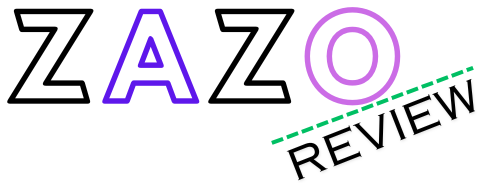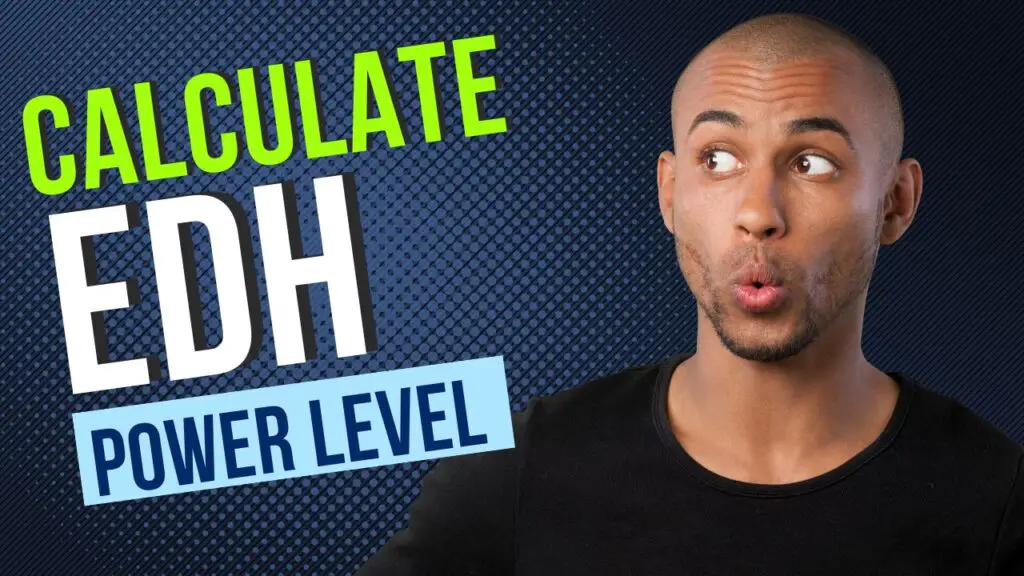An EDH Power Level Calculator is an online tool that helps players evaluate the power level of their EDH decks. The power level of a deck is determined by factors such as average CMC, draw engines, tutors, ramp, and interaction.
By inputting these variables, the calculator generates a rough estimate of the deck’s power level. This tool is useful for players looking to assess the competitiveness of their deck and compare it to other decks in the format. With the rise in popularity of EDH, having a reliable method to measure power level can aid in creating balanced and enjoyable gameplay experiences.
Edh Power Level Calculator In Practice
Achieving the perfect power level for your Commander deck can be a challenging task. It requires a precise understanding of deck strength assessments and essential metrics used in power level calculations. To ensure accurate evaluations, players often compare manual and automated methods. In this article, we will explore the practical aspects of the Edh Power Level Calculator and how it can enhance your deck-building process.
Understanding Deck Strength Assessments
When it comes to determining the power level of your EDH deck, understanding deck strength assessments is crucial. By analyzing various factors, you can accurately gauge the competitiveness and capabilities of your deck. Some key aspects to consider include:
- Turn Count: Determining the average turn count required for your deck to achieve a victory can give insight into its power level. A lower turn count usually indicates a higher power level.
- Card Interactions: Assessing the synergy and interactions between cards in your deck can significantly impact its power level. Combos, efficient synergies, and powerful interactions raise a deck’s overall strength.
- Consistency: Evaluating the consistency of your deck’s performance across multiple games can help determine its power level. A deck that consistently performs well is likely to have a higher power level than one that is inconsistent.
By considering these factors, you can accurately assess the strength of your deck and make adjustments accordingly.
Essential Metrics Used In Power Level Calculations
Power level calculations utilize various essential metrics to provide an objective assessment of a deck’s strength. These metrics take into account critical aspects of a deck and assign a numerical value to indicate its power level. Some commonly used metrics in power level calculations include:
- Average CMC (Converted Mana Cost): This metric determines the overall mana curve of a deck. A lower average CMC often suggests a faster and more powerful deck.
- Draw Engines: Assessing the number and effectiveness of draw engines in a deck can indicate its ability to maintain card advantage and consistency.
- Tutors: Tutors allow players to search for specific cards in their deck, enhancing the deck’s consistency and enabling powerful plays. Evaluating the number and quality of tutors in a deck gives insight into its potential power level.
- Ramp: Examining the amount of ramp cards in a deck helps determine its ability to generate resources efficiently and accelerate its gameplay.
- Interaction: Interaction refers to the deck’s capability to respond to threats and disrupt opponents’ strategies. Evaluating the amount and effectiveness of interaction cards is vital in assessing a deck’s power level.
By analyzing these essential metrics, the Edh Power Level Calculator can provide accurate insights into the strength of your deck.
Comparing Manual And Automated Evaluation Methods
Traditionally, players relied on manual evaluation methods to assess the power level of their decks. However, with advancements in technology, automated evaluation methods have become increasingly popular. Let’s explore the benefits of each approach:
| Manual Evaluation | Automated Evaluation |
|---|---|
| Requires subjective judgments based on experience and knowledge. | Utilizes algorithms and statistical analysis for objective evaluations. |
| Allows personalized assessment based on individual playstyle and preferences. | Provides consistent and standardized evaluations for fair comparisons. |
| Relies on players’ expertise and understanding of the game’s dynamics. | Reduces biases and human errors by relying on data-driven calculations. |
While both manual and automated evaluation methods have their advantages, using the Edh Power Level Calculator can save time and provide reliable assessments.
In conclusion, the Edh Power Level Calculator is a valuable tool that enhances the deck-building process by providing accurate power level evaluations. By understanding deck strength assessments, essential metrics used in power level calculations, and comparing manual and automated evaluation methods, you can optimize your deck’s competitiveness and overall performance.
Assess Your Deck’s Strength With Confidence
Assess your deck’s strength with confidence using the EDH Power Level Calculator. Determine the power level of your Commander deck by tracking its performance and analyzing key factors such as turn count, average CMC, draw engines, tutors, ramp, and interaction.
Don’t rely on guesswork, use this valuable tool to optimize your gameplay.
Interpreting Calculation Outputs For Better Gameplay
Once you have used the Edh Power Level Calculator to assess your deck’s strength, it’s important to understand how to interpret the calculation outputs for better gameplay. The calculator takes into account various factors such as Average CMC, Draw engines, Tutors, Ramp, and Interaction to provide you with an estimation of your deck’s power level. Let’s delve deeper into each of these components:
Average CMC
The Average CMC, or Converted Mana Cost, represents the average mana cost of your deck’s cards. Lower Average CMCs tend to indicate faster and more streamlined gameplay, while higher Average CMCs suggest a slower and potentially more powerful deck. Analyze your deck’s Average CMC output to understand its overall speed and efficiency.
Draw engines
Draw engines refer to the cards and mechanisms within your deck that allow you to consistently draw additional cards. High-powered draw engines can give you more options and keep your hand full throughout the game. Evaluate the Draw engines output to determine the card advantage potential of your deck.
Tutors
Tutors are cards that enable you to search your library for specific cards, allowing you to access key pieces of your strategy. The presence of tutors in your deck can greatly increase its consistency and reliability. Consider the Tutors output to understand the versatility and control your deck possesses.
Ramp
Ramp refers to the cards that accelerate your mana production, allowing you to cast spells more quickly. A well-balanced ramp package can provide you with the necessary resources to execute your game plan effectively. Analyze the Ramp output to determine the speed and efficiency of your mana acceleration.
Interaction
Interaction refers to the cards within your deck that can directly interact with your opponents’ strategies. These cards can disrupt your opponents’ plans, protect your own assets, or create advantageous situations. The Interaction output can give you insights into the level of control and resilience your deck possesses.
Balancing Deck Components For Optimized Results
Now that you have a better understanding of the calculation outputs, it’s time to balance your deck components for optimized results. Consider the following tips to enhance your deck’s power level:
- Adjusting the Average CMC: If your deck has a high Average CMC, consider including lower-cost cards to increase its speed and consistency.
- Exploring Different Draw Engines: Experiment with various draw engines to maximize your card advantage potential and ensure a steady flow of resources throughout the game.
- Strategic Tutors: Select tutors that align with your deck’s strategy and enable you to access essential cards at critical moments.
- Efficient Ramp: Opt for efficient ramp cards that provide a significant boost to your mana production, allowing you to cast spells ahead of your opponents.
- Diverse Interaction: Incorporate a mix of interactive cards that can handle a range of threats and disrupt your opponents’ plans effectively.
By carefully balancing these deck components, you can optimize your deck’s power level and increase its chances of success on the battlefield. Confidence in your deck’s strength will enhance your overall gameplay experience and make you a more formidable opponent.
Navigating The Edh Power Level Landscape
When it comes to playing the popular format of Elder Dragon Highlander (EDH), also known as Commander, understanding the power level of your deck is essential. The power level of your EDH deck determines how competitive and balanced your gameplay experience will be. To help players evaluate the power level of their decks, an EDH Power Level Calculator has become an invaluable tool.
Recognizing Different Tiers Of Edh Gameplay
Recognizing the different tiers of EDH gameplay is crucial in navigating the power level landscape. EDH power levels are often classified into tiers ranging from Casual to Competitive. Understanding which tier your deck falls into can help you find opponents with similar power level decks, leading to more enjoyable and balanced games.
Here is a breakdown of the different tiers:
| Tier | Description |
|---|---|
| Casual | Decks in this tier focus on casual and thematic gameplay. They often prioritize flavor and fun over optimized strategies and cards. |
| Focused | Decks in this tier are more focused and optimized, but still maintain a balance between strong cards and casual themes. They can be competitive within their own tier. |
| Optimized | Decks in this tier are optimized for power and efficiency. They include powerful cards and synergies to maximize their performance while still maintaining a sense of fun. |
| Competitive | Decks in this tier are finely tuned for maximum competitiveness. They prioritize winning above all else and often utilize powerful cards and strategies to dominate the game. |
How Meta Influences Edh Deck Power Levels
The meta, or the current state of the game, significantly influences EDH deck power levels. The meta consists of the decks and strategies prevalent in the local playgroup or the larger EDH community. Understanding the meta is crucial in determining the appropriate power level for your deck.
Here are some key points to consider when it comes to the influence of the meta:
- Meta trends: The meta constantly evolves as new sets are released and new strategies emerge. Keeping an eye on the meta trends can help you adapt your deck’s power level accordingly.
- Power level inflation: As the meta becomes more competitive, the overall power level of decks tends to increase. It’s important to assess and adjust your deck’s power level to keep up with the evolving meta.
- Local playgroup: The power level of your local playgroup can heavily influence your deck’s power level. It’s crucial to communicate and align with your playgroup to ensure everyone is having a balanced and enjoyable playing experience.
Navigating the EDH power level landscape can be daunting, but with the help of an EDH Power Level Calculator and an understanding of the different tiers of gameplay and the influence of the meta, players can better assess and adjust their decks’ power levels. So go ahead and explore the power level calculator, refine your deck, and dive into the exciting world of EDH.
Factors That Affect Your Power Level
When it comes to playing EDH (Elder Dragon Highlander), understanding the factors that affect your power level is crucial. In this section, we will explore some key elements that can significantly impact the strength of your deck. By examining the importance of synergy and consistency, as well as the role of tutors, ramp, and draw, we can better assess and optimize our power level.
Importance Of Synergy And Consistency
Synergy and consistency play a vital role in determining the power level of a deck. Synergy refers to how well the cards in your deck work together, complementing each other’s abilities and strategies. A highly synergistic deck can achieve powerful combinations and game-changing effects, effectively raising its power level. On the other hand, a lack of synergy can result in a deck that feels disjointed and underwhelming.
Consistency is equally important. A consistent deck is one that can reliably execute its game plan and maximize its potential in every game. This involves having a balance of cards that allow for smooth gameplay and minimize inconsistencies or dead draws. Consistency ensures that your deck consistently performs at its intended power level.
Role Of Tutors, Ramp, And Draw In Power Assessment
When assessing the power level of a deck, it’s crucial to consider the role of tutors, ramp, and draw. These three elements play a significant part in the overall strength and performance of a deck.
- Tutors: Tutors are cards that allow you to search your library for specific cards. They provide consistency and flexibility by enabling you to find key combo pieces or powerful spells when you need them most. Decks with efficient and versatile tutors tend to have higher power levels, as they can consistently access their most impactful cards.
- Ramp: Ramp refers to cards that accelerate your mana production and allow you to play spells ahead of schedule. This includes cards like sol ring or mana dorks. Ramp is vital because it helps you develop a strong mana base and get ahead of your opponents in terms of available resources. Higher ramp capabilities generally correlate with a higher power level.
- Draw: Draw cards are essential for maintaining a healthy card flow and ensuring that you have options and answers at every stage of the game. Drawing cards allows you to consistently draw into more powerful spells and maintain a hand size advantage. Decks with strong draw engines often have a higher power level, as they can maintain a steady stream of resources and options.
By considering the role of tutors, ramp, and draw in your deck, you can more accurately assess its power level. These elements contribute to the consistency and strength of your overall strategy, ultimately influencing the power level of your deck.
Maximizing Deck Performance
Maximize your deck performance with the help of an EDH Power Level Calculator. Determine your deck’s power level based on turn counts and win consistency, allowing you to fine-tune your strategy for optimal results.
Strategic Tweaks To Enhance Deck Strength
One of the keys to becoming a successful EDH player is constantly evaluating and improving your deck’s performance. By strategically tweaking your deck, you can enhance its overall strength and increase your chances of winning. Whether you’re looking to fine-tune your existing deck or build a new one from scratch, here are some expert tips to help you maximize your deck’s power level:
Tips For Adjusting To The Competitive Edh Environment
- Focus on card selection: In a competitive EDH environment, every card counts. It’s important to carefully consider each card’s impact on your deck’s overall strategy and power level. Consider cards with high synergy and efficiency to ensure optimal performance.
- Streamline your mana curve: A well-balanced mana curve is crucial for consistent performance. Aim to have a good distribution of low, mid, and high-cost cards to ensure smooth gameplay. Eliminate any cards that consistently underperform or disrupt your game plan.
- Utilize strategic tutors: Tutors can greatly increase your deck’s consistency and reliability. Look for tutors that allow you to search for specific cards, helping you find key pieces of your strategy when you need them most.
- Include powerful draw engines: Drawing cards is essential for card advantage and maintaining a healthy hand size. Incorporate draw engines that allow you to refill your hand throughout the game, giving you more options and increasing your overall power level.
- Strengthen your ramp: A well-ramped deck can quickly snowball to victory. Include a variety of efficient ramp cards to accelerate your mana production, giving you an advantage over slower opponents.
- Add interaction and disruption: In a competitive environment, having ways to disrupt your opponents’ game plan is crucial. Include removal spells, counterspells, and other interactive cards that can both protect your own board state and disrupt your opponents’ strategies.
- Stay informed: The competitive EDH landscape is constantly evolving. Stay up-to-date with the latest metagame trends, deck archetypes, and strategies by regularly exploring online resources such as forums, Reddit, and dedicated EDH websites.
Finding Your Deck’s Place In The Meta
When it comes to playing Commander, understanding the power level of your deck is crucial for finding your deck’s place in the meta. Whether you’re playing casually or competitively, having a clear idea of your deck’s power level will help you adapt your strategy, align your expectations with other players, and find the right opponents to play against. One tool that can assist you in this process is the EDH Power Level Calculator.
Utilizing The Edh Power Level Calculator For Meta Analysis
The EDH Power Level Calculator is an online tool that allows you to evaluate the power level of your EDH deck. It takes various factors into account, such as the average converted mana cost, draw engines, tutors, ramp, and interaction in your deck. By inputting this information, the calculator generates an estimated power level for your deck, helping you understand where it stands in the meta.
To use the EDH Power Level Calculator, simply provide the necessary details about your deck, such as the average converted mana cost, draw engines, tutors, ramp, and interaction. The calculator then analyzes this information and assigns a power level to your deck. This will give you a clear perspective on how your deck matches up against other decks in the Commander format.
Adapting Your Strategy To Match Power Level Expectations
Once you have determined the power level of your deck using the EDH Power Level Calculator, it’s important to adapt your strategy accordingly. Understanding the power level of your deck allows you to set reasonable expectations when playing against other players. If your deck is on the higher end of the power level spectrum, it’s important to recognize that you may need to dial back your strategy when playing against decks with lower power levels to ensure a balanced and enjoyable play experience for all.
On the other hand, if your deck’s power level is lower, you can focus on enhancing your strategy and improving your deck over time. By recognizing the power level of your deck, you can pinpoint areas for improvement and make targeted upgrades to enhance your performance in the meta.
Remember, the goal is not to make your deck the most powerful one on the table, but rather to find a balance where all players can have engaging and enjoyable games. By utilizing the EDH Power Level Calculator and adapting your strategy to match power level expectations, you can ensure a more harmonious play environment and increase your enjoyment of the Commander format.
Continuous Deck Improvement Cycle
Building a strong and competitive EDH deck is not a one-time endeavor. It requires continuous effort, analysis, and adjustment. This is where the Continuous Deck Improvement Cycle comes into play. By regularly reviewing and reassessing the power level of your deck with the help of the Edh Power Level Calculator, you can identify areas for improvement and make the necessary changes to maintain a strong deck.
Reviewing And Reassessing With The Edh Power Level Calculator
The Edh Power Level Calculator is a valuable tool that allows you to evaluate the power level of your EDH deck. To make the most of this tool, follow these steps:
- Upload your decklist: Start by uploading your decklist to the Edh Power Level Calculator. This will provide the necessary information for the calculator to assess the power level of your deck.
- Enter relevant factors: Indicate the average converted mana cost (CMC) of your deck, the draw engines you have included, the tutors you are using, the amount of ramp available, and the level of interaction your deck possesses. These factors play a significant role in determining the power level.
- Calculate the power level: Once you have provided the necessary information, the calculator will generate an estimate of your deck’s power level. This score will give you a baseline to work from.
Once you have obtained the power level estimate, it’s time to reassess your deck. Consider the following:
- Identify weaknesses: Look for areas where your deck may be lacking. Are there any cards that are underperforming or not contributing to your game plan? Is there a particular aspect of your deck that could be improved?
- Seek opportunities for improvement: Research new cards, strategies, or combos that could enhance your deck’s power level. Explore different synergies and evaluate their potential impact on the overall performance of your deck.
- Rethink your deck’s focus: Based on the power level estimate and your research, consider if your deck needs to be refined or redirected. Do you need to shift your focus towards a different theme or strategy?
Long-term Strategies For Maintaining A Strong Edh Deck
Building a strong EDH deck is not just about making short-term improvements. It’s also important to have long-term strategies in place to ensure the continued strength of your deck. Here are some strategies to consider:
- Regularly playtest: By consistently playing your EDH deck against different opponents, you can gather valuable data and identify any weaknesses or inconsistencies. This will enable you to fine-tune your deck and make the necessary adjustments.
- Stay updated with new releases: Keep an eye on new card sets and expansions as they are released. Look for cards that can synergize with your current deck or potentially replace underperforming cards.
- Participate in the EDH community: Engaging with the EDH community can provide valuable insights and perspectives. Join online forums, attend local EDH events, and discuss strategies with fellow players. This will broaden your knowledge and help you discover new ideas for improving your deck.
- Invest in upgrades over time: Building a competitive EDH deck can be a significant investment. Instead of making all the updates at once, consider a gradual approach. Regularly invest in new cards and upgrades that align with your long-term strategy.
Remember, the key to maintaining a strong EDH deck is to continuously review, reassess, and adapt. Utilize tools like the Edh Power Level Calculator and combine them with long-term strategies to ensure your deck remains competitive in the ever-evolving world of EDH.

Credit: www.reddit.com
Frequently Asked Questions Of Edh Power Level Calculator
How Do You Determine Commander Power Level?
To determine Commander power level, some players use a turncount method. By playing the deck multiple times and noting the consistently winning turn, you can gauge the power level. Lower turncounts indicate higher power levels.
What Is A Power Level 7 Commander Deck?
A power level 7 Commander deck is a deck that is considered to be moderately strong in terms of gameplay. It performs well and has a good balance of strategy and card interactions. Players use various methods, such as evaluating turn counts and win rates, to determine the power level of their deck.
How Do You Calculate Human Power Level?
You can calculate a human power level by using a turncount method. Play your deck multiple times and note which turn it consistently wins on. A lower turncount indicates a higher power level.
What Power Level Is A Precon?
The power level of a Precon is variable and can vary depending on the specific preconstructed deck.
Conclusion
To accurately determine the power level of your EDH deck, using an EDH Power Level Calculator can be incredibly helpful. This online tool takes into account various factors such as average CMC, draw engines, tutors, ramp, and interaction. By inputting your decklist, the calculator provides a rough estimate of your deck’s power level.
This allows you to evaluate and make necessary adjustments for a more balanced and enjoyable playing experience. Rather than relying on guesswork, let the EDH Power Level Calculator assist you in gauging the strength of your deck.

I am a Water Heater specialist writer and blogger based in the USA & UK. I have been working with Water Heater for six long years. And I give trips on various Water Heater problems and solutions. I have a lot of experience with Water Heater And I share them here

